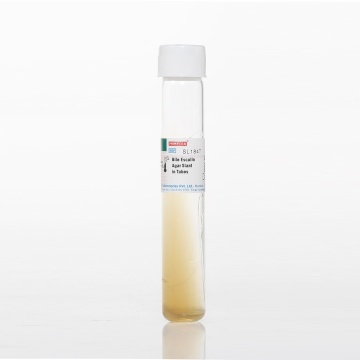 Your enquiry has been submitted
Your enquiry has been submitted
HiCrome™ M-TEC Agar
Intended Use
Recommended for differentiation and enumeration of thermotolerant Escherichia coli from water by membrane filter technique.
Composition**
| Ingredients | g / L |
|---|---|
| Proteose peptone | 5.000 |
| Yeast extract | 3.000 |
| Lactose | 10.000 |
| Sodium chloride | 7.500 |
| Dipotassium hydrogen phosphate | 3.300 |
| Potassium dihydrogen phosphate | 1.000 |
| Sodium lauryl sulphate (SLS) | 0.200 |
| Sodium deoxycholate | 0.100 |
| Chromogen | 0.500 |
| Agar | 15.000 |
Final pH ( at 25°C) 7.3±0.2
**Formula adjusted, standardized to suit performance parameters
Directions
Suspend 45.6 gram in 1000 ml purified / distilled water. Heat to boiling to dissolve the medium completely. Sterilize by autoclaving at 15 lbs pressure (121°C) for 15 minutes. Cool to 45-50°C. Mix well and pour into sterile Petri plates.
Principle And Interpretation
HiCrome™ M-TEC Agar is a chromogenic media used for detection and enumeration of thermo-tolerant E.coli (TEC) in water by membrane filtration developed by Dufour (1). The modified medium contains the chromogen, 5-bromo-6-chloro-3-indolyl-β-D-glucuronide that is cleaved by enzyme β-D-glucuronidase to yield glucuronic acid, produced by E.coli strains. This imparts a purple-magenta colour to the colonies of E. coli only. E.coli can be isolated from samples. Proteose peptone and yeast extract provides carbon, nitrogen substances, long chain amino acids, vitamins and essential nutrients. Lactose is the fermentable carbohydrate. Sodium chloride maintains osmotic equilibrium. Potassium dihydrogen phosphate and dipotassium hydrogen phosphate provide strong buffering system to control the pH in the presence of fermentative action. Sodium lauryl sulphate and sodium deoxycholate make the medium more selective by inhibiting gram positive bacteria. Membrane filter through which water sample has been passed is aseptically placed on the medium. The plates are then incubated at 44.5 ± 0.2°C for 22 - 24 hours. Following incubation E.coli will form purple to magenta coloured colonies on the membrane filters.
Type of specimen
Water samples
Specimen Collection and Handling
For water samples, follow appropriate techniques for sample collection, processing as per guidelines and local standards (2). After use, contaminated materials must be sterilized by autoclaving before discarding.
Warning and Precautions
Read the label before opening the container. Wear protective gloves/protective clothing/eye protection/ face protection. Follow good microbiological lab practices while handling specimens and culture. Standard precautions as per established guidelines should be followed while handling specimens. Safety guidelines may be referred in individual safety data sheets.
Limitations
- Individual organisms differ in their growth requirement and may show variable growth patterns on the medium.
- Each lot of the medium has been tested for the organisms specified on the COA. It is recommended to users to validate the medium for any specific microorganism other than mentioned in the COA based on the user’s unique requirement.
- Further biochemical and serological test are necessary for confirmation.
Performance and Evaluation
Performance of the medium is expected when used as per the direction on the label within the expiry period when stored at recommended temperature.
Quality Control
Appearance: Cream to yellow homogeneous free flowing powder
Gelling: Firm,comparable with 1.5% Agar gel
Colour and Clarity of prepared medium: Light amber coloured, clear to slightly opalescent gel forms in Petri plates
Reaction: Reaction of 4.56% w/v aqueous solution at 25°C. pH : 7.3±0.2
pH: 7.10-7.50
Cultural Response: Cultural characteristics observed after an incubation at 44.5±0.2°C for 22-24 hours.
| Organism | Inoculum (CFU) | Growth | Colour of Colony |
|---|---|---|---|
| Escherichia coli ATCC 25922 (00013*) | 50-100 | good to luxuriant | purple/magenta |
| Enterococcus faecalis ATCC 29212 (00087*) | >=10⁴ | inhibited | - |
| Proteus mirabilis ATCC 25933 | 50-100 | good | colourless-light brown |
| Klebsiella pneumoniae ATCC 13883 (00097*) | 50-100 | good | tan-light purple |
Key : *Corresponding WDCM numbers.
Storage and Shelf Life
Store between 15-25°C in a tightly closed container and the prepared medium at 2-8°C. Use before expiry date on the label. On opening, product should be properly stored dry, after tightly capping the bottle in order to prevent lump formation due to the hygroscopic nature of the product. Improper storage of the product may lead to lump formation. Store in dry ventilated area protected from extremes of temperature and sources of ignition Seal the container tightly after use. Product performance is best if used within stated expiry period.
Disposal
User must ensure safe disposal by autoclaving and/or incineration of used or unusable preparations of this product. Follow established laboratory procedures in disposing of infectious materials and material that comes into contact with sample must be decontaminated and disposed of in accordance with current laboratory techniques (3,4).
Reference
- Dufour,Strickland and Cabelli, 1981, Appl. Environ. Microbiol. 41: 1152.
- Lipps WC, Braun-Howland EB, Baxter TE,eds. Standard methods for the Examination of Water and Wastewater, 24th ed. Washington DC:APHA Press; 2023.
- Isenberg, H.D. Clinical Microbiology Procedures Handbook. 2nd Edition.
- Jorgensen, J.H., Pfaller, M.A., Carroll, K.C., Funke, G., Landry, M.L., Richter, S.S and Warnock., D.W. (2015) Manual of Clinical Microbiology, 11th Edition. Vol. 1.
| Product Name | HiCrome™ M-TEC Agar |
|---|---|
| SKU | M1571 |
| Product Type | HiCrome™ |
| Physical Form | Powder |
| Origin | Animal |
| Packaging type | HDPE |
| References | 1.U.S. Environmental Protection Agency, 2002, Method 1603; Publication EPA-821-R-02-023.2.Dufour,Strickland and Cabelli, 1981, Appl. Environ. Microbiol. 41: 1152.3.Baird R.B., Eaton A.D., and Rice E.W., (Eds.), 2015, Standard Methods for the Examination of Water and Wastewater, 23rd ed., APHA, Washington, D.C 4.Isenberg, H.D. Clinical Microbiology Procedures Handbook. 2nd Edition.5.Jorgensen,J.H., Pfaller , M.A., Carroll, K.C., Funke, G., Landry, M.L., Richter, S.S and Warnock.,D.W. (2015) Manual of Clinical Microbiology, 11th Edition. Vol. 1 |
| Customized Product Available | No |







